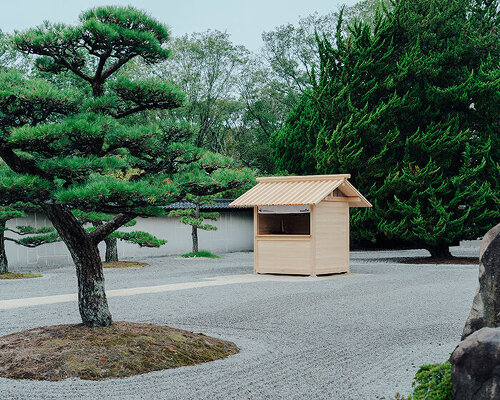hiroshima international architecture festival launches in japan
designboom visits Japan’s inaugural Hiroshima International Architecture Festival 2025, which runs from October 4 to November 30 across the twin cities of Fukuyama and Onomichi. Conceived as a triennial event by the Kambara–Tsuneishi Cultural Foundation, the festival invites 23 architects and artists from Japan and abroad to explore the future of cities and the role of architecture in revitalizing local communities through a series of exhibitions, site-specific installations, and talks.
Bringing together major figures such as Tadao Ando, Toyo Ito, Arata Isozaki, Sou Fujimoto, and SANAA alongside younger practices including Studio Mumbai, VUILD, and Clouds Architecture Office, the festival spans a wide range of generations and approaches. From historical retrospectives to experimental installations, the program reveals how Japanese architecture continues to evolve between craftsmanship and technology, tradition and experimentation.
Tsuboya kiosk by Yasushi Horibe Kiosk (all images by Tatsuya Tabii, unless stated otherwise)
Onomichi show links design heritage and new visions
Set across seven venues, the first edition of the festival brings together Japan’s most celebrated modernists and the country’s emerging voices. Tadao Ando’s Onomichi City Museum of Art hosts Nine Visions: Japanese Architects from Japan to the World, a survey of all nine Japanese recipients of the Pritzker Architecture Prize. The exhibition traces the profound Japanese influence on global architectural discourse through the works of Kenzo Tange, Fumihiko Maki, Tadao Ando, Toyo Ito, Kazuyo Sejima and Ryue Nishizawa of SANAA, Shigeru Ban, Arata Isozaki, and Riken Yamamoto. In front of the museum, Shigeru Ban’s Paper Log House, originally developed for disaster relief after the 1995 Kobe earthquake, stands as a symbol of social responsibility in architecture.
Nearby, Studio Mumbai has renovated the 1960s building LOG into a combined exhibition space and hotel. The project includes an interactive display that explores how people’s everyday lives connect with design. This adaptive reuse effort, now attracting about 30,000 visitors a year, shows how craftsmanship and thoughtful use of materials can root modern architecture in the existing character of a city. Similarly, Junya Nagasaka’s LLOVE HOUSE Onomichi turns an abandoned home into a lively center for cultural exchange. Photographer Yurika Takano’s exhibition, Transferring Bodies, Transferring Architecture, complements this by capturing Onomichi’s historic streets and how they have changed over time.
the festival brings together 23 architects and artists from Japan and abroad
fukuyama: architecture as a living ecosystem
In Fukuyama, Shinshoji Zen Museum and Gardens presents Next Architecture: Connecting Futures Through Design, featuring works by Sou Fujimoto, Junya Ishigami, Norihisa Kawashima, Hiroki Akiyoshi, president of VUILD, and Clouds Architecture Office. Through models and proposals, the exhibition explores how architecture, the environment, and society interact, imagining how future cities could better live in balance with nature and culture.
Within the same temple grounds, Kenzo Tange’s self-designed residence, originally built in Tokyo’s Seijo neighborhood in 1953 and later demolished, is the subject of a preview exhibition for a planned reconstruction project in Fukuyama. The display includes a one-third-scale model and archival material that contextualizes Tange’s legacy and influence on postwar Japanese architecture. Complementing these exhibitions is Norihisa Kawashima’s Compost Bench, a circular environmental project that transforms fallen leaves from the maple trees around the temple into compost to nourish them anew.
Shinshoji Zen Museum and Gardens presents Next Architecture: Connecting Futures Through Design
Temporary Pavilions Shape the Landscape
A series of small, movable pavilions, described as micro-architectures, punctuate the urban landscape throughout Hiroshima International Architecture Festival 2025. Designed by Yasushi Horibe, Junya Ishigami, and Hideyuki Nakayama, each kiosk interprets the notion of transience and locality in a different way. Horibe’s Tsuboya functions as a small tea stand at Shinshoji Temple, while Nakayama’s Kiosk Through Which the Landscape Passes (Catch) stands by the waterfront at Onomichi U2. Ishigami’s Clouds Descend, planned as the festival’s information center at Fukuyama Station, was delayed in transit due to a typhoon, a reminder, perhaps, of architecture’s delicate relationship with the natural world.
the program reveals how Japanese architecture continues to evolve | image © designboom
cultivating a new culture
The organizers of the Hiroshima International Architecture Festival see the event as a platform to nurture creativity, education, and civic imagination using architecture as a tool for regional regeneration and intergenerational dialogue. Alongside the exhibitions, the program includes talks and public discussions with leading figures such as Sou Fujimoto, Toyo Ito, and Junya Ishigami, as well as workshops for children and film screenings.
The greatest achievement of the festival may be its integration of architecture with place, allowing audiences to inhabit design. By placing together historical temples, modern museums, and lived cityscapes, the event transforms Hiroshima Prefecture into a landscape of ideas. With its next edition planned for 2028, the festival’s debut suggests the beginning of a meaningful, long-term dialogue, one that could evolve into Japan’s answer to the Venice Architecture Biennale.
Onomichi city museum by Tadao Ando | image © designboom
Circular Kaname – Nature Connected Architecture by Norihisa Kawashima
using branches, leaves, and grass from the temple garden | image © designboom
Kenzo Tange’s home model
a lost residence recreated as a 1:3 scale model | image © designboom
the exhibition explores how architecture, the environment, and society interact | image © designboom
Shodo by Terunobu Fujimori | image © designboom
Norihisa Kawashima’s Compost Bench transforms fallen leaves into compost | image © designboom
Shigeru Ban’s Paper House
project info:
name: Hiroshima International Architecture Festival 2025 | @hiroshima_arch_exhibition
dates: October 4th – November 30th, 2025
venues: Fukuyama & Onomichi, Hiroshima Prefecture, Japan
organizer: Kambara–Tsuneishi Cultural Foundation
The post preview visit of inaugural hiroshima international architecture festival 2025 appeared first on designboom | architecture & design magazine.

